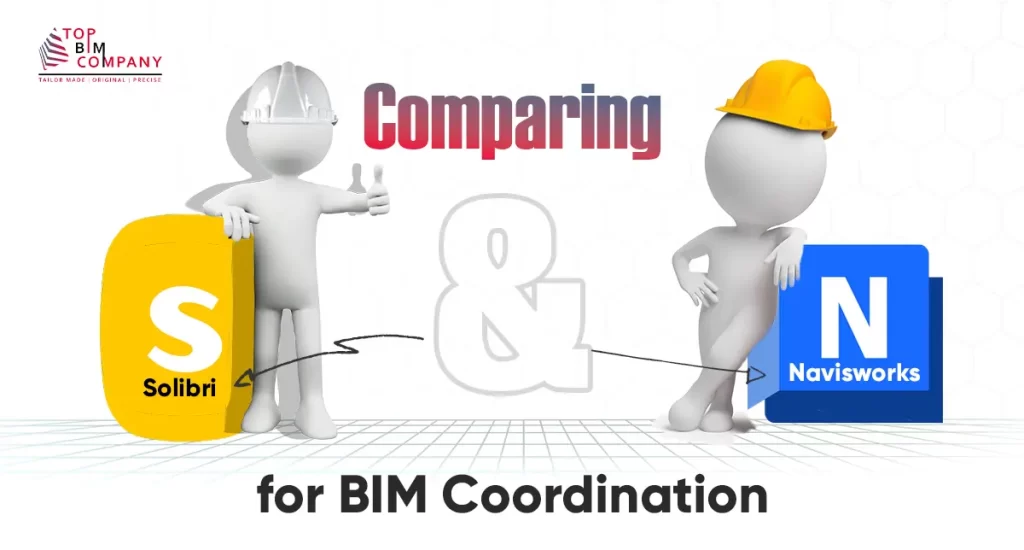
Significance of BIM in the European construction sector – A digital method for generating and maintaining data on a building or infrastructure project over the course of its lifecycle is called building information modeling. BIM technology allows stakeholders to collaborate on a single digital model of the project, which can be used to improve communication, coordination, and decision-making.
Table of Contents
ToggleYou May like to Read:
How is BIM Growing in the USA Construction Industry?
How is BIM Growing in the Indian construction industry?
BIM is playing an increasingly significant role in the European construction sector. The European Commission has recognized the potential of BIM to boost productivity and efficiency in the sector and has launched several initiatives to promote its adoption.
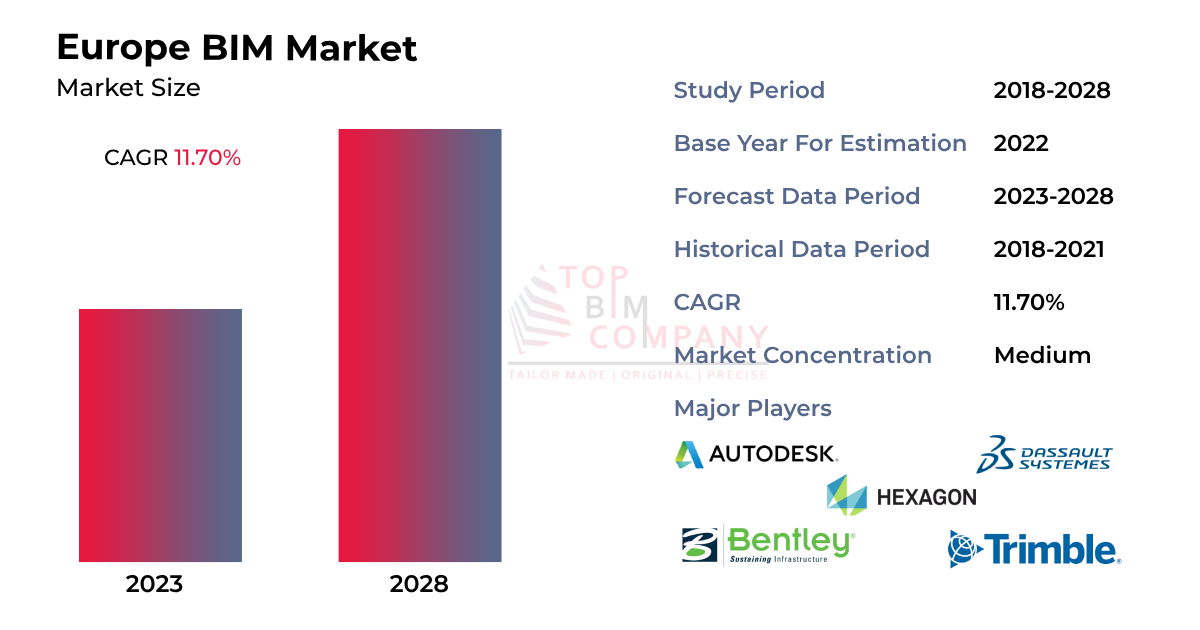
Historical Perspective
BIM technology emerged in the early 1970s, but it was not until the late 1990s that it began to gain traction in the construction industry. Europe was one of the early adopters of BIM, with countries such as the United Kingdom and Norway leading the way.
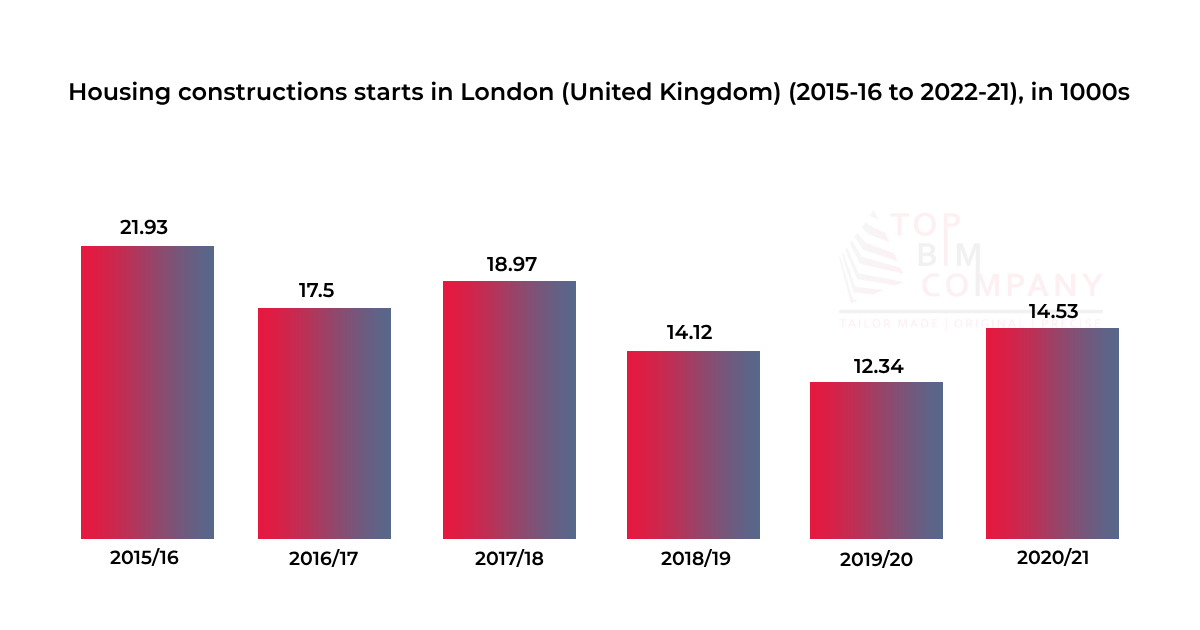
Current State of BIM in Europe:
BIM adoption in Europe is still in its early stages, but it is growing rapidly. According to a recent report by Mordor Intelligence, the European BIM market is expected to grow at a CAGR of 11.7% during the forecast period 2022-2027.
BIM is being used in a wide range of construction projects in Europe, from small residential buildings to large infrastructure projects. Some of the key players and stakeholders in the European BIM landscape include:
- Government agencies: European governments are playing a leading role in promoting the adoption of BIM. Many countries have introduced BIM mandates and regulations for public sector projects.
- Construction companies: Construction companies are increasingly recognizing the benefits of BIM and are investing in BIM technology and training.
- Architecture and engineering firms: Architecture and engineering firms are also adopting BIM in order to improve collaboration and efficiency.
- Software vendors: A number of software vendors offer BIM software solutions to meet the needs of different users in the construction sector.
According to NBS statistics, 73% of businesses used BIM in their projects and were familiar with the technology in 2020. A decade ago, only 13% of developers used BIM, and 43% were not even aware of it, according to statistics from 2011.
Only 1% of UK businesses did not know about BIM in 2020. This indicates that although BIM has been around for a while in the UK, most awareness and adoption have occurred in the last ten years. Small firms are less likely to utilize BIM for a variety of reasons; in the UK, just 62% of small businesses with fewer than 15 employees use BIM, compared to 80% of large businesses that actively use it.
The building industry’s digitalization is becoming more widely acknowledged as a possible game-changer that might greatly advance sustainable development under the European Green Deal and the “Europe fit for digital age” goals.
Global cost savings of EUR 0.6 trillion to EUR 1.0 trillion (13% to 21%) in the engineering and construction phases and EUR 0.3 trillion to EUR 0.4 trillion (10% to 17%) in the operations phase41 are predicted to result from full-scale digitalization in non-residential construction within the next ten years.
Fred Mills from The B1M provides a concise overview of the essential BIM Protocol, a seemingly mundane yet pivotal document for Building Information Modeling (BIM) projects, developed by the UK’s Construction Industry Council.
The Protocol serves as a standardized legal agreement easily incorporated into professional service appointments and construction contracts. Its primary goal is to facilitate information model production at defined project stages, fostering collaboration, appointing an Information Manager, and ensuring common standards.
The Protocol introduces additional obligations and rights for Employers and contracted Parties, emphasizing the direct contractual relationship. It crucially requires inclusion in contracts for all contributors to guarantee consistent standards and working practices.
The video highlights the need for careful consideration of version consistency, unaltered wording, and proper listing of information models. While effective at BIM Level 2, the industry may need to reassess contracting methods as it progresses to BIM Level 3 and further digitization.
Benefits of BIM in Construction
In Europe, Building Information Modeling is revolutionizing construction by fostering collaboration, enabling precise visualization, and promoting sustainability. It streamlines communication and decision-making, enhancing overall project efficiency and outcomes.
Improved Project Efficiency and Cost Savings:
- Early identification and resolution of potential problems
- Optimization of construction schedules, leading to cost reduction
- Waste reduction through efficient planning
Enhanced Collaboration and Communication:
- Facilitates seamless collaboration among diverse project stakeholders
- Common digital model accessible and updatable globally
- Streamlined communication for better project coordination
Sustainability and Environmental Considerations:
- Supports sustainable construction practices
- Optimizes energy performance for reduced environmental impact
- Minimizes material waste through effective resource management
Challenges and Barriers
Regulatory and Standardization Issues:
- Lack of harmonized BIM standards and regulations in Europe
- Hindrance to cross-country collaboration and implementation
Technological and Skill-Related Challenges:
- Complexity and expense of BIM technology implementation
- Shortage of skilled BIM professionals in the European market
Data Privacy and Security Concerns:
- Generation of large data volumes raises privacy and security issues
- Necessity for robust measures to address data security concerns
Despite these challenges, the European market stands at the crossroads of seizing the transformative benefits of BIM while addressing these barriers through collaborative efforts, technological advancements, and a strategic focus on skill development.
Few Successful BIM projects in Europe
There are a number of successful BIM projects in Europe, including:
Aylesbury Crown, in Aylesbury, United Kingdom:

Prior to the shovel ever touching the ground at the newly constructed Aylesbury Crown, in the United Kingdom, the design team concluded that constructing an information model has demonstrated usefulness on the £35 million endeavor.
Designers discovered several methods for utilizing the technology to save time and money while improving correspondence with Her Majesty’s Court Service and other team members.
The 5,200-sq-meter project, which was designed by the London offices of HOK with Turner & Townsend and AECOM, combines four courts into one facility along with public hall administration, consultation and witness rooms, judicial and custody accommodation and secure external areas.
BIM Project ESEAN Nantes, France:
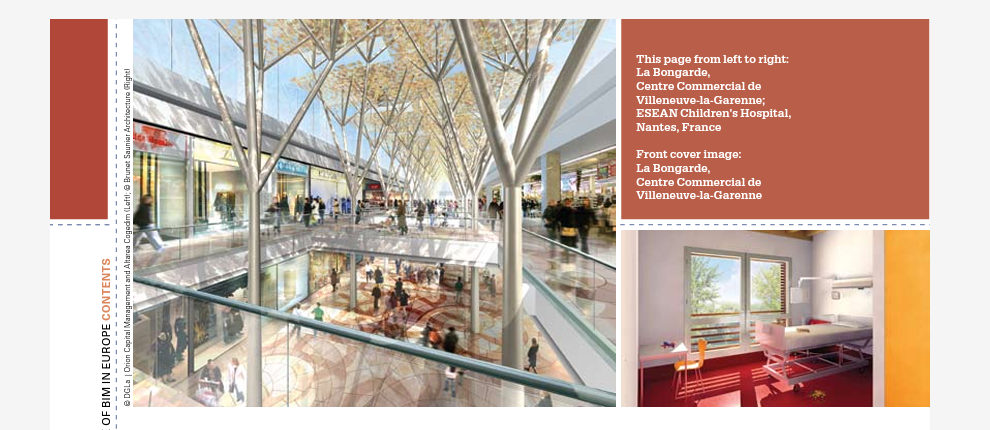
The 6,700 square meter ESEAN children’s hospital in Nantes, France was designed using BIM. The €10 million project consists of an upper-floor inpatient hospital with patient rooms and common areas, as well as a ground-floor outpatient hospital with space for about 90 patients.
BIM gave the designers the most freedom to examine various iterations of the same façade and determine which was the best option.
BIM in Commercial Building: La Bongarde, Villeneuve-la-Garenne, France:
In addition to commercial developers, building information modeling has gained traction swiftly on various institutional projects around Europe.
Using BIM, designers at the 250,000-square-meter, €140-million La Bongarde project, a commercial center constructed in Villeneuve-la-Garenne, France, can promptly and accurately provide continuing design revisions for potential tenants while also assisting the owner in closely monitoring costs.
BIM adoption varies across Europe
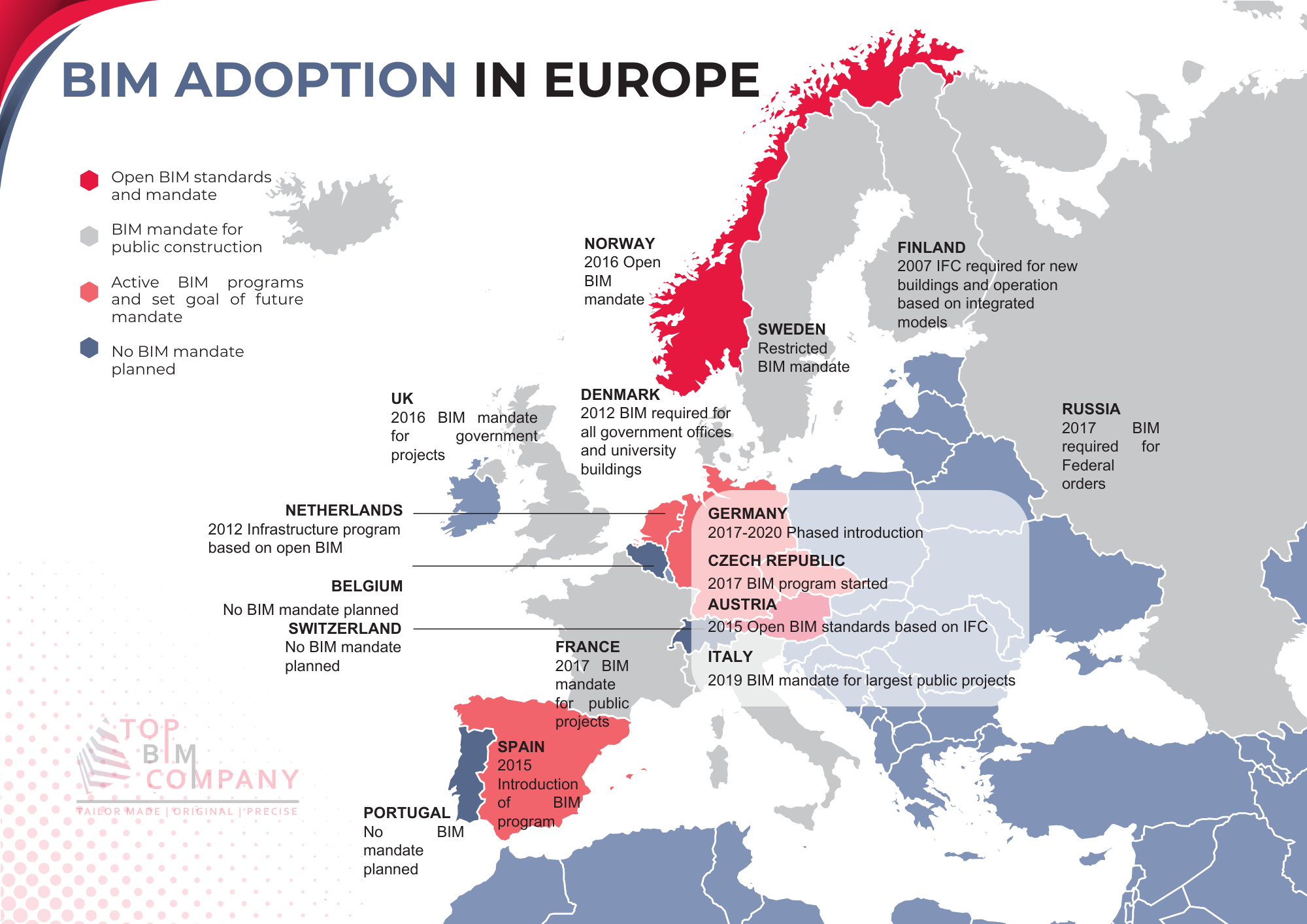
Finland mandated IFC in 2007, Norway embraced Open BIM in 2016, and Denmark required BIM for government buildings in 2012. The UK implemented a BIM Mandate in 2016, while Germany phased in BIM from 2017 to 2020.
Belgium and Switzerland have no immediate plans for a BIM mandate. The diverse approaches highlight the dynamic landscape of BIM adoption in Europe.
Government Initiatives and Policies
Role of European governments in promoting BIM:
European governments are playing a leading role in promoting the adoption of BIM. They are doing this by:
- Introducing BIM mandates and regulations for public sector projects
- Providing financial and technical support to businesses and organizations to implement BIM
- Raising awareness of the benefits of BIM through education and training programs
- Establishing BIM standards and guidelines
BIM mandates and regulations:
A number of European countries have introduced BIM mandates and regulations for public sector projects. This means that construction companies are required to use BIM on all public sector projects over a certain value. This has helped to drive the adoption of BIM in the private sector as well.
Some examples of European countries with BIM mandates include:
- United Kingdom
- Finland
- Denmark
- Germany
- Norway
- Sweden
- Netherlands
- Belgium
- France
- Spain
- Italy
Future Trends and Innovations
Exploring New Frontiers: Innovations in the European Market:
In the ever-evolving landscape of the European market, a surge in innovation is reshaping the focus on various sectors. Notably, the heritage sector is witnessing a notable emphasis, driving increased investment and advancements in scan-to-BIM technology.
AI and Machine Learning Revolutionizing BIM:
Artificial Intelligence (AI) and Machine Learning (ML) are at the forefront of reshaping Building Information Modeling (BIM) applications. These technologies are catalyzing advancements in:
- Automated Clash Detection: Streamlining the identification and resolution of clashes in the design and construction phases.
- Quantity Take-offs: Enhancing accuracy and speed in material quantity estimations.
- Predictive Maintenance: Enabling proactive maintenance strategies through data analysis.
- Performance Analysis: Providing comprehensive insights into the performance of structures and systems.
The integration of AI and ML in BIM applications is poised for significant growth in the future. The driving force behind this trajectory lies in the ability of AI and ML to automate tasks, thereby enhancing the overall efficiency of BIM workflows. This automation expedites processes and augments the precision and intelligence applied throughout the project lifecycle.
As the European market continues to embrace these technological advancements, the symbiotic relationship between AI, ML, and BIM is anticipated to unlock new possibilities and redefine the standards of excellence in the built environment.
Stay tuned as the future unfolds with transformative innovations in BIM, heralding a new era of efficiency and intelligence.
Integration of BIM with other emerging technologies:
BIM is being integrated with other emerging technologies, such as:
- Drones
- 3D printing
- Virtual reality (VR)
- Augmented reality (AR)
The integration of BIM with other emerging technologies is opening up new possibilities for the construction sector.
For example, drones can be used to capture 3D data of construction sites, which can then be used to update BIM models. VR and AR can be used to visualize BIM models and conduct virtual walkthroughs of buildings and infrastructure projects before they are built.
Sustainable and smart city projects leveraging BIM:
A number of sustainable and smart city projects in Europe are leveraging BIM. For example:
- The HafenCity project in Hamburg, Germany, is using BIM to design and build a sustainable and smart waterfront district.
- The SmartSantander project in Santander, Spain, is using BIM to improve the efficiency and sustainability of city services.
- The Amsterdam Smart City project in Amsterdam, the Netherlands, is using BIM to create a more livable and sustainable city.
Milestone of BIM Adoption in Europe
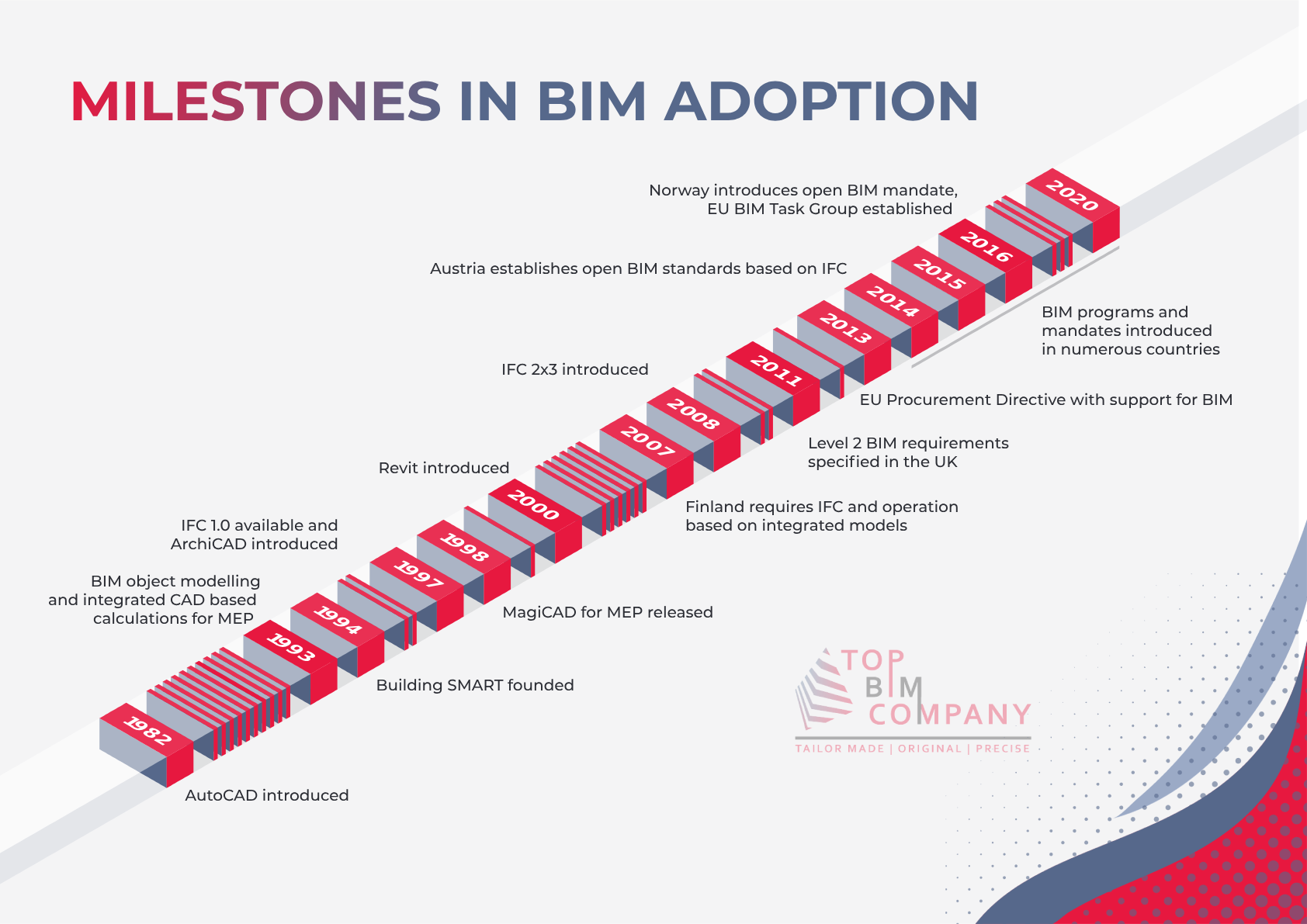
The timeline of Building Information Modeling (BIM) is marked by key milestones. AutoCAD’s introduction in 1982 initiated digital design, while the founding of Building SMART in 1994 laid the foundation for collaborative BIM efforts. The year 2000 brought about a revolution with the introduction of Revit.
Notably, in 2007, Finland mandated IFC, showcasing practical BIM application. Standardization advanced with IFC 2*3 in 2008, and by 2011, the UK specified Level 2 BIM requirements.
The EU Procurement Directive in 2013 and Austria’s adoption of open BIM standards in 2014 reflected a growing global trend.
The pivotal year 2016 witnessed a surge in global BIM programs and mandates, including Norway’s open BIM mandate and the establishment of the EU BIM Task Group. These milestones encapsulate the transformative journey of BIM adoption.
Final Thought:
In Europe, Building Information Modeling (BIM) stands as a catalyst for innovation in the construction sector. Its widespread adoption reflects a commitment to efficiency, collaboration, and sustainability.
As BIM continues to shape the industry landscape, it transforms the way projects are designed and executed and underscores Europe’s embrace of cutting-edge technology to elevate construction practices and outcomes.
This technological evolution aligns with the region’s broader economic growth, positioning BIM as a pivotal driver in enhancing productivity and competitiveness within the European construction industry.
To know more about BIM implementation, contact expert BIM engineers of Top BIM Company in USA.
Our Services
Latest Post
Get A Free Quote
BIM Construction is the Future
Building information modeling (BIM) is the future of building design and construction. Get in touch with our BIM Experts.



